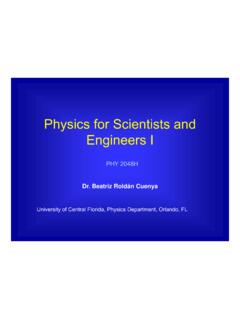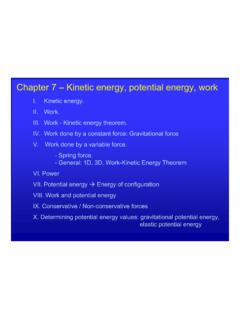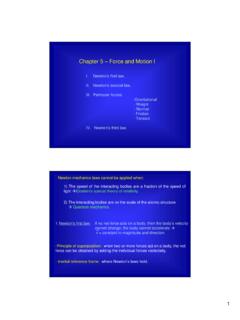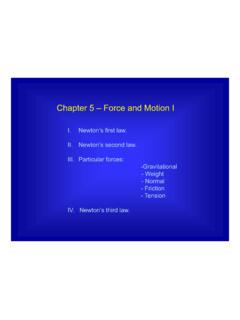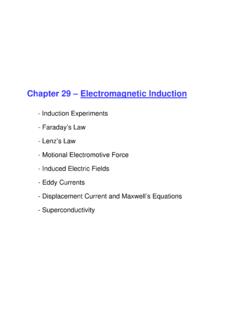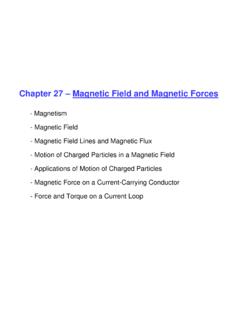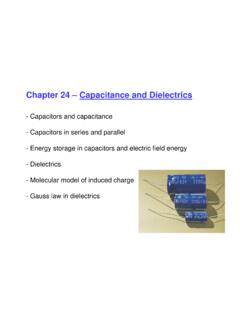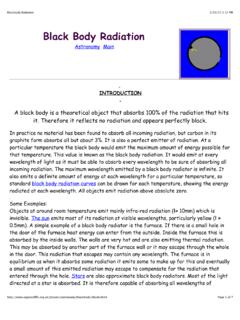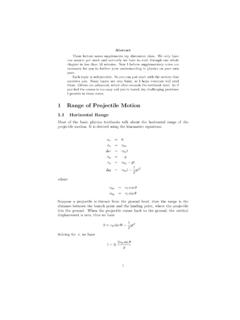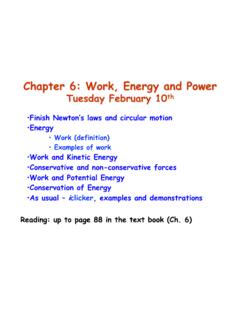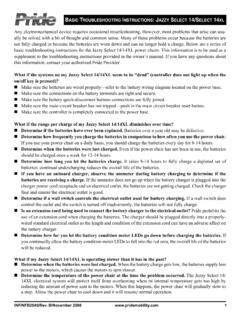Transcription of Chapter 10 – Rotation and Rolling - Physics
1 Chapter 10 Rotation and RollingII. Rotation with constant angular accelerationIII. Relation between linear and angular variables- Position, speed, variables- Angular position, displacement, velocity, accelerationIV. Kinetic energy of rotationV. Rotational inertiaVI. TorqueVII. Newton s second law for rotationVIII. Work and rotational kinetic energyIX. Rolling motionI. Rotational variablesRigid body:body that can rotate with all its parts locked together andwithout shape Rotation axis:every point of a body moves in a circle whose center lieson the Rotation axis. Every point moves through the same angle duringa particular time position:the angle of the reference line relative to the positivedirection of the : radians (rad)Reference line:fixed in the body, perpendicular to the Rotation axis and rotating with the Note:we do not reset to zero with each complete Rotation of the reference line about the Rotation axis.
2 2 turns =4 Translation:body s movement described by x(t). Rotation :body s movement given by (t) = angular position of the body s reference line as function of displacement:body s Rotation about its axis changing theangular position from 1to Clockwise Rotation negativeCounterclockwise Rotation positiveAngular velocity:tttavg 1212dtdtt 0limAverage:Instantaneous:Units:rad/s or rev/sThese equations hold not only for the rotating rigid body as a whole butalso for every particle of that body because they are all locked speed ( ):magnitude of the angular acceleration:tttavg 1212dtdtt 0limAverage:Instantaneous:Angular quantities are normally vector quantities right hand rotates around the direction of the vector avector defines an axis of Rotation not the direction inwhich something is :angular velocity, angular accelerationAngular quantities are normally vector quantities right hand :angular displacementsThe order in which you add two angulardisplacements influences the final result isnot a Rotation with constant angular acceleration20000202200021)(21)(221atvtx xtvvxxxxavvattvxxatvv Linear equationsAngular equations20000202200021)(21)(221tttttt III.
3 Relation between linear and angular variablesPosition:rs always in radiansSpeed:rvdtdrdtds in rad/sSince all points within a rigid body have the sameangular speed , points located at greater distancewith respect to the rotational axis have greater linear(or tangential) speed, is tangent to the circle in which a point movesIf =constant, v=constant each point within the body undergoesuniform circular of revolution: 222 rrvrTAcceleration:rarrdtddtrddtdvt )(Tangential componentof linear accelerationRadial component oflinear acceleration:rrvar 22 Responsible for changes in the direction of the linear velocity vector vIV. Kinetic energy of rotationReminder:Angular velocity, is the same for all particles within therotating velocity,v of a particle within the rigid body depends on theparticle s distance to the Rotation axis (r).
4 Units:m/s2 Responsible for changes inthe magnitude of the linearvelocity vector )( iiiiiiiiirmrmvmmvmvmvKRotational inertia = Moment of inertia, I: iiirmI2 Indicates how the mass of the rotating body isdistributed about its axis of moment of inertia is a constant for a particularrigid body and a particular Rotation :kg m2 Example:long metal rotational inertia in (a) easier to IK Kinetic energy of a body in pure rotationKinetic energy of a body in pure translation221 COMMvK V. Rotational inertiaDiscrete rigid body I= miri2 Continuous rigid body I= r2dmParallel axis theorem2 MhIICOM Proof:Rotational inertia about a given axis= RotationalInertia about a parallel axis that extends trough body sCenter of Mass + Mh2h = perpendicular distance between the given axisand axis through COM.
5 DmbaydmbxdmadmyxdmbyaxdmrI)(22)()()(2222 222R22222 MhIMhbMyaMxdmRICOMCOMCOM VI. TorqueTorque: Twist Turning action of force F .FrFrFrFrt )sin()sin( r : Moment arm of Fr : Moment arm of FtUnits:NmSign:Torque >0 if body rotates <0 if clockwise principle:When several torques act on a body, the net torqueis the sum of the individual torquesVector quantityTangential component, Ft:does cause Rotation pulling a door perpendicular to its Radial component, Fr:does not cause Rotation pulling a door parallel to door s Newton s second law for Rotation ImaF Proof:Particle can move only along the circular path only the tangential component of the force Ft(tangent to the circular path) can accelerate theparticle along the path. ImrrrmrmarFmaFtttt )()(2 Inet VIII.
6 Work and Rotational kinetic energyTranslationRotationWmvmvKKKifif 222121 WIIKKK ifif 222121 fixxFdxW fidW Work-kinetic energy TheoremWork, Rotation about fixed axisdFW )(ifW Work, constant torquevFdtdWP dtdWPPower, Rotation about fixed axisProof:22222222222121)(21)(21)(21)(21 2121ifififififIImrmrrmrmmvmvKKKW fidWddrFdsFdWtt dtddtdWPIX. Rolling - Rotation + Translation Smooth Rolling motionExample:bicycle s motion of any round body Rolling smoothly over a surface can beseparated into purely rotational and purely translational Pure axis through point where wheel contacts speed about P = Angular speed about O for stationary )(2)2)(( - Kinetic energy of Instantaneous velocity vectors= sum of translationaland rotational A Rolling object has two types of kinetic energy ICOM 2(about its COM).
7 Mv2 COM(translation of its COM).- Forces of Rolling .(a) Rolling at constant speed no sliding at P no friction.(b) Rolling with acceleration sliding at P friction force opposed to friction wheel does not slide smoothrolling motion aCOM= RSlidingIncreasing accelerationExample1:wheels of a car moving forward while its tires are spinningmadly, leaving behind black stripes on the road Rolling with slipping =skidding Icy braking systems are designed to ensure that tires roll withoutslipping during :ball Rolling smoothly down a ramp. (No slipping).Sliding tendency2. Rolling without sliding the point of contactbetween the sphere and the surface is at rest the frictional force is the static frictional Work done by frictional force = 0 the pointof contact is at rest (static friction).
8 1. Frictional force causes the Rotation . Withoutfriction the ball will not roll down the ramp,will just :ball Rolling smoothly down a ,,sin Note:Do not assume fs=fs,max. The only fsrequirement is that itsmagnitude is just right for the body to roll smoothly down the ramp,without s second law in angular form Rotation about center of mass0 NFsfgsfRFr 2,,RaIfRaIIfRIxCOMCOMsxCOMCOMCOM snet 2,,2,2,,/1sinsin)(sinsinMRIgaMgaRIMMaMgR aIfMaMgfcomxCOMxCOMCOMxCOMxCOMCOMsxCOMs Linear acceleration of a body Rolling along anincline plane2 MRIhgvMghMRIvMghMvRvIMghMvIUKUKCOMCOMCOM COMCOMCOMCOMCOMCOM iiff Example:ball Rolling smoothly down a ramp of height hConservation of EnergyAlthough there is friction (static), there is no loss of Emec because the point of contact with the surface is at rest relative to the surface at any instant-Yo-yoPotential energy (mgh) kinetic energy.
9 Translational( ) and rotational ( ICOM 2)Analogous to body Rolling down a ramp:- Yo-yo rolls down a string at an angle =90 withthe Yo-yo rolls on an axle of radius Yo-yo is slowed by the tension on it from ,/1/1sinMRIgMRIgacomcomxCOM
